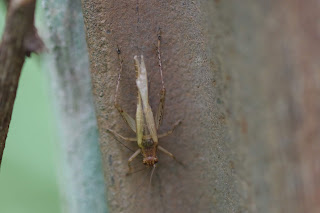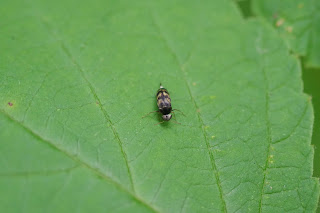Meanwhile, outside there are a million crickets, and, in fact, all sorts of members of the order Orthoptera. Orthoptera include 3 kinds (I don't know the scientific term) of insects: crickets, grasshoppers, and katydids. I saw many examples of each in the backyard today (except grasshoppers. I only saw two grasshoppers):
I posted pictures of several species of katydids yesterday, and oddly, there were none of this species. What is odd about it is that today I must have seen at least a dozen, and this is the kind I see most often. While two of the species I saw yesterday were not to be seen today (and I did look for them), this one was well represented.
This is a female; the spike on the back end is an ovipositor.
Grasshopper. It looks like it is missing part of its rear leg.
Katydid on goldenrod. I am not going to bother looking up the species, because I know from experience that I am still not going to be able to figure that out.
Cricket
I saw a lot more crickets than I am going to be posting; crickets, especially species that are ground dwellers, can be difficult to photograph. In this case you can probably see why–it is very easy for them to disappear in the grass.
This one was under the picnic table, so I couldn't get closer than this.
Male–no ovipositor.
Female
Female–the curved thing at the back is an ovipositor.
I don't think I have seen this species of cricket before, but with its mangled wings it's kind of hard to tell.
Katydids can be hard to spot, because many of the species blend in well with leaves. I often find them only because they are moving. Can you spot the katydid?
It is the one that became an imago yesterday. I'll give you a hint: look for the legs.
Here it is! (It is facing the other direction in the picture. I took this about an hour earlier than the other one, and it had moved in the interim).
Grasshopper
Backyard Bug of the Day:
Sweat bee on a plant I think is called mountain mint.
Other Bugs:
There was a monarch among the milkweed today. I think she laid some eggs, but mostly she just seemed to be resting on the plants.
The double-toothed prominent does a pretty thorough job of devouring leaves.
There was something I didn't mention about the moth that was Backyard Bug of the Day yesterday, or about moths in general. Some species of female moths don't fly anywhere after they eclose, they just stay in the spot where they pupated and wait for a mate to come by, attracting males with pheromones. Gypsy moths do this, and in some species of moths, the white marked tussock moth in particular, the female doesn't even have wings. She ecloses, mates, lays her eggs on her own cocoon, and that is her entire moth life. It appears that this crocus moth is another species in which the female ecloses and remains on the spot and waits for a mate. And she found one, or rather, one found her.
Tumbling flower beetle
Wasp on mountain mint
Hopper
Damselfly
I read recently that milkweed tussock moth caterpillars can wipe out an entire stand of milkweed rather quickly. That has not happened in my backyard, even though I have seen several broods of them. But they have completely devoured a few plants. This one, where Brood #2 used to live, has one leaf left beside this one.
Moth
Hopper nymph
More ants tending to I think the same species of hopper. These ants are much smaller, though.
Leaf-footed bug nymph
Hopper on glass
Arachnid Appreciation:
.
.
.
.
.
.
.
.
.
.
.
.
Spider hiding
Funnel web spider, its web full of sawdust.
Flower crab spider on mountain mint. You can see the same spider above in one of the other pictures of this wasp. I didn't point it out so the arachnophobes would not notice it.
There's one here, too–can you spot it? A spider, that is, not an arachnophobe.
Jumping spider










































No comments:
Post a Comment